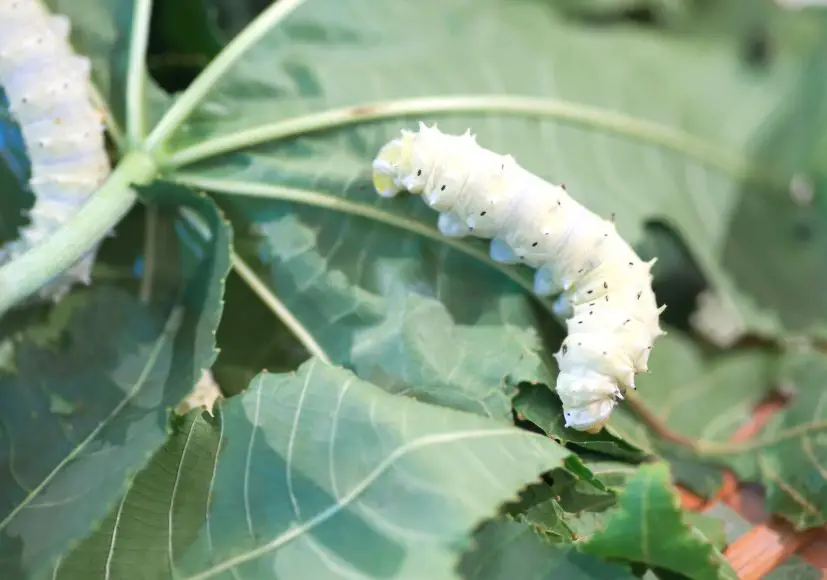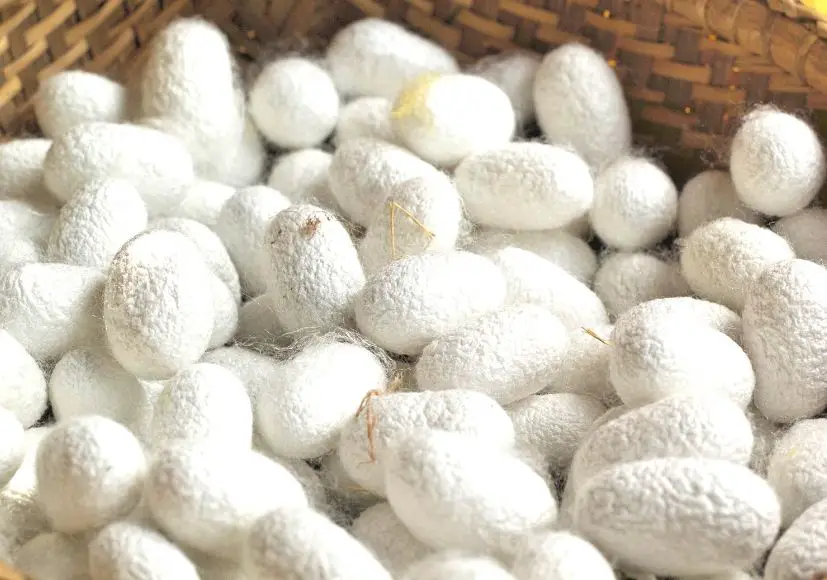Table of Contents
**This page contains affiliate links and I will be compensated if you make a purchase after clicking on my links**
Many years ago, I toured the beautiful country of China. One of the highlights of my trip was a trip to a silk factory outside Shanghai. Some of the silk from the silkworm pupae was pulled into thread and woven to make silk fabric. Alternatively, the water-soaked cocoons could be stretched to make silk stuffing for comforters and pillows.
This latter stretching process was done by hand, with four women slowly stretching a mound of silk fibers to cover a comforter-sized area.
In addition to its smooth and shiny appearance, silk has added benefits that may significantly improve your comfort
Silk production is thought to have originated in China, around 4000 BC or so. Over the millennia, other countries have taken on silk production, including Europe and Japan. But with time those industries have declined, and now China is again the number one exporter of silk.
Due to its shiny, smooth feel, silk is associated with luxury. Importing goods from a faraway land, such as China, wasn’t as easy as it is today, adding to its value.
Where does silk come from?
Silk is a natural fiber made by the silkworm. Silkworms aren’t actually “worms”, but instead the larval form of the silk moth.
Insects, including moths and butterflies, go through several stages of development, called metamorphosis. After hatching from an egg, the hungry caterpillar (larva) spends its days eating. When ready, it then wraps itself in a protective cocoon (pupa), while it waits to develop into its final adult form.
In the case of the silk moth, this cocoon is made of spun silk, made by the caterpillar.
The most common silk is mulberry silk, which comes from the mulberry silkworm, Bombyx mori. As the name implies, these silkworms consume the leaves from the mulberry tree.
Silk producers raise their domesticated silkworms from eggs. Once the eggs hatch, the caterpillars spend around 30-40 days eating, before settling in to spin their cocoons.
What is silk made of?
Raw silk is composed of two glycoproteins, fibroin and sericin. Fibroin forms the silk filament, while sericin, a gummy substance, holds the cocoon together.
Fibroin is hydrophobic (“hydro” = water; “phobic” = fear) and resistant to water. Sericin is the opposite: it’s hydrophilic (“philic” = love), and dissolves in water. This allows the sericin to be removed from fibroin by simple washing.
To harvest silk, the cocoons are first exposed to either steam or hot air to kill the pupa. Then the cocoons are boiled to soften the sericin, loosening the silk fibers.
The silk can be unraveled from the cocoons and rolled up into spools of thread. Or the emptied cocoons can be stretched to form stuffing material.
Further boiling in soap and water removes the sticky sericin, leaving the lustrous fibroin silk fibers we’re familiar with.

Why is silk good for bedding?
Despite its looks, silk is far from “delicate” having a remarkably high mechanical strength. Indeed, for many decades it was used as a suture material for surgeries (although synthetic sutures are used today).
In addition to its strength, silk has other key properties that enhance your comfort.
Silk is highly breathable and excellent at absorbing and wicking away moisture. Likewise, its heat retention ability is low. This keeps you cool and dry.
As such, silk is ideal to wear in summer, or have in your bed, especially if you “sleep hot”.
Because it stays dry, you are less likely to have a humid microclimate under the sheets. Many things propagate in a humid environment, including bacteria, fungi, and dust mites.
For most of us, those things are not an issue. (Although it’s still important to launder your bedding on a regular basis.)
But for those of us with allergies, asthma, and skin issues, those things definitely are an issue. The less, the better.
Using silk (or fabric with similar drying properties) in combination with a regular laundry schedule should keep your bed free of these nasties.
On the downside, silk is poor at conducting electricity, and may, therefore, be prone to static cling under dry conditions. However, static cling can be easily managed.
Yes, silk is pricey. Instead of covering your entire bed, consider trying out silk pillowcases.
Because silk is smooth, it doesn’t “pull” on hair as you sleep and toss around. You may wake up with less “bed head”, frizz, or breakage. Likewise, less pulling is also important if you are prone to thinning hair.
For this reason, some women choose to sleep in a cap lined with smooth material, either silk or “satin” made of silk-like polyester.
Why is silk good for your skin?
While silk is good at wicking away excess moisture, its smoothness leaves alone the moisture you need. Your skin may not become as dry as with other rougher fabrics (like say, cotton). This is good for your hair, scalp, face, and whole body.
Likewise, the smoothness of silk is less likely to agitate sensitive skin.
Yes, “silk protein” is a common ingredient in moisturizers, and other products for skin, hair, and nails. And yes, it does have anti-aging and anti-wrinkle effects.
However, that ingredient is sericin, the protein that was washed away during processing to make silk thread.
Unfortunately, there is little evidence that silk pillowcases will noticeably reduce the signs of aging.
Silk may help indirectly by not tugging on your skin or leaving indentations. Plus silk leaves your face moisturized, which could also help.
Does silk help acne?
Because silk is smooth and resists the growth of bacteria, it shouldn’t aggravate acne. This is an improvement over other rougher fabrics (e.g. cotton).
It may prevent outbreaks, but on its own, it’s unlikely to improve chronic acne.
Instead consider a pillowcase containing copper or silver. Metals have direct anti-bacterial properties which may help with acne.
Either way, switch out your pillowcases for freshly laundered ones every two-three days. The last thing you want is for the regular oil and dirt that gets deposited on your pillow to clog your pores and cause a breakout.
Benzoyl peroxide and silk
If you have acne, you are likely to use benzoyl peroxide on your face or body. Yes, peroxide is a bleaching agent. Avoid using any pillowcases or towels that are not white or off-white in color.
Indeed, you may have already solved this problem by laying an old cotton towel over your pillow. Or using benzoyl peroxide-resistant sheets. Except now you’re sleeping on either rough cotton or 100% polyester microfiber, respectively. Neither are great fabrics for your skin.
Small amounts of peroxide can weaken the silk. This small amount may be okay, but regardless, I wouldn’t spend a lot on these pillowcases.
As you probably don’t want face-shaped bleach stains on your pillowcase, shop for off-white.
What is momme?
“Thread count” does not apply to silk fabric. For silk, momme (pronounced either “mom” or “mom may”) is a measurement of fabric density.
Specifically, it is the weight in pounds of a piece of fabric 45 inches by 100 yards.
Your thin silk “chiffon” scarf has a momme of 6-8. “Gauze” is even lighter and thinner, with a momme of 3-5.
For sheets you’ll want something heavier, 19-25 momme is recommended.

Care of silk
In general, follow the directions provided by the manufacturer. However, you are allowed some latitude.
Silk can shrink if not pre-washed, which is why some silk is “dry-clean only”
In a previous post, I ignored most of the provided instructions and washed my silk pillowcases on the regular wash cycle in hot water. Except for a tiny bit of shrinkage, they came out just fine. (At least in the short term…)
I used my regular “free & gentle” detergent, however, detergent designed for silk is recommended.
If you choose to use your own detergent, check the label to make sure it does NOT contain oxygen bleach or enzyme additives. Enzymes break down complex carbohydrates (sugars) or proteins from stains. Remember that silk is a glycoprotein, a protein with attached sugars.
- Check out smartlabel.org for the ingredients of common consumer products
(Oops, turns out my favorite detergent isn’t exactly “gentle”. It contains amylase, an enzyme that breaks down starch. More concerning is the addition of subtilisin, an enzyme that attacks protein… Am I damaging my silk over time? Stay tuned…)
If you wish to take fewer risks, also stick with cold water and the delicate cycle. The delicate cycle reduces the time and speed of your spin cycle. Weaker, and low momme, silk is less likely to withstand these shear forces.
Hand washing will be gentler than your machine. Dry cleaning is also an option.
- Wash in a load without zippers or other snag risks. Alternatively, place your silk in a mesh bag.
Silk dries very quickly, so there is no need to put it in the dryer. If you’ve machine-washed it, the spin cycle will have removed most of the water. Hang dry or lay flat.
- Do not wring dry
If it’s too wet (perhaps you decided to wash by hand) instead, place it between two towels, roll everything up, then gently wring the roll.
- If hang drying, avoid exposure to direct sunlight
Sunlight will not only fade the color but will erode the silk itself. (This is why curtains are not made of silk. If you want the “silk look” use satin, which is made from 100% polyester.)
- If you choose to iron, use the cool setting
Considering ironing from the reverse side or place a cloth between the silk and your iron.
- Never ever use chlorine bleach, as it will destroy the silk
Also avoid oxygen bleach (hydrogen peroxide) and high pH additives, such as sodium carbonate (“washing soda”). Likewise, avoid baking soda and Borax®. Or enzyme-based cleaners.
All of these work by dissolving stains made of protein. But silk is ALL protein…
(Another protein-based fiber, wool, should also be washed without these laundry additives.)
Small amounts will weaken the silk, altering its feels; larger amounts will destroy it.
When storing silk, do not store it in plastic, as moisture can become trapped. Instead, store it in a breathable blanket storage bag or a pillowcase.
Silk bedding and cats
Cats have good taste. They love silk. They tend to “knead” things they love.
This behavior is left over from when they were nursing kittens and kneaded their mom to get the milk to come down.
“Furry” fabrics are more often the target of kneading, but silk, Lyocell, linen, and cotton all may be victims.
Many cat parents will keep their fur babies’ nails trimmed, but I have not had much success with mine sitting still for a mani-pedi.
So, my bedding suffers. Sometimes it is small holes that can simply be fixed by running a fingernail across the fibers. More serious, is a broken or a pulled thread.
Although this can happen with any fiber, smooth fibers, especially silk, are more susceptible to this type of damage.
Which is why I’m not too concerned with the protein-dissolving enzymes in my laundry detergent. The cats will destroy the silk long before that…
Top photo: (c) by kieferpix via Canva.com
Want to learn more about the products mentioned?
[If you experience issues with menus or links not working, it is most likely due to your Ad blocker.]


